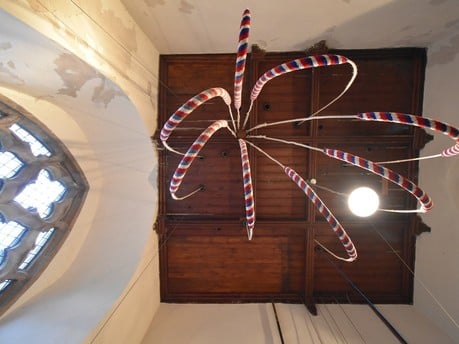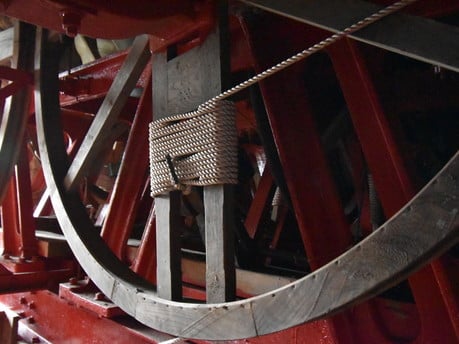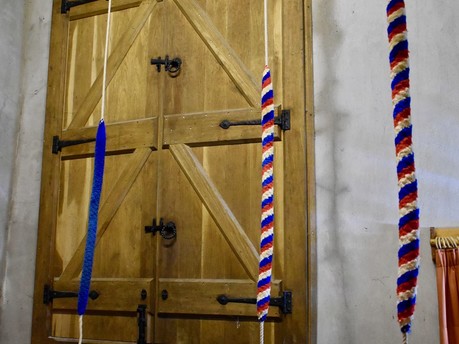
Ringing the changes
The traditional sounds of Christmas take many forms, but few are as joyous or distinctive as the ringing of church bells.
Of course, church bells are also rung throughout the year in celebration of various feast days and public events, and in West Wales, the duties are carried out by the St David’s Diocesan Guild of Bell Ringers.
The Guild recently marked the 75th anniversary of its formation, although current circumstances ensured there was little opportunity to celebrate the historic landmark and no bells rang out to honour such longevity – particularly given the somewhat low expectations for success the Guild faced during its early days.
The St David’s Diocesan Guild of Bell Ringers was formed on September 29, 1945, with a vision to bring together active bellringers from across the three counties of Pembrokeshire, Carmarthenshire and Ceredigion – the Diocese of St David’s. Prior to its inauguration, many of the region’s ringers attended meetings either within the Swansea & Brecon Guild or the then West Wales Association.
Some three months after it was formed, the Guild was recognised in the Central Council of Church Bell Ringers’ weekly journal The Ringing World on January 4, 1946, where it was noted: “In the remoter part of Wales a new St David’s Diocesan Guild has come into being and its fortunes and future will be watched with sympathetic interest in all parts of the country.”
It was a less than ringing endorsement of the fledgling group.
But despite such scepticism, the Guild began with nine ringable towers within its region and it burst into life with a quarter peal at St David’s Cathedral the day after its formation.
Two months later, it rang a full peal at Tenby.
A peal is the name given to a specific form of bellringing which meets certain exacting conditions for duration, complexity and quality.
For a performance to be recognised as a peal it must consist of sufficient numerical sequences - or changes. A peal must consist of at least 5,040 changes on up to seven working bells or 5,000 changes on higher numbers.
On typical tower bells a full peal takes around three hours to ring, although the actual length of time depends on several factors including the number of changes and the weight of the bells involved, which affects the speed of ringing.
Quarter peals, which are a quarter of the length of a full peal, take around 45 minutes to complete.
“There is a whole language associated with bellringing,” said Anne Bunker, Guild Master of the St David’s Diocesan Guild of Bell Ringers.
However, despite such precise terminology, bellringing is much less complicated than it sounds and goes far beyond the simple fulfilling of religious duties. Dedicated bellringers view the practice as a hobby, a social exercise and just good, plain fun.
“Bellringing is a very inclusive activity,” said Anne.
“We are very welcoming and open to anyone joining – and you often find that once someone becomes a bellringer it develops into a passion.”
Bellringing itself dates back many hundreds of years and for modern-day practitioners, the art forms a direct link between bellringers past and present across time and geography.
Technically, the controlled ringing we hear today is known as change ringing – the origin of the phrase “to ring the changes” - and came about following the invention of full-circle tower bells in the early 1600s when it was discovered that swinging a bell on a pivot through a much wider arc offered the bellringer far greater control over the timing and sound of strikes compared to a swing over a shorter, limited arc.
“It is such an old activity, going all the way back to the Middle Ages,” said Anne.
“It has developed and evolved over the centuries, but it still centres on controlling the sound being made by the bell.
“There are people who have spent their lives arranging the order and pattern of ringing, depending on the number and size of bells in each tower.”
Despite encompassing such a large geographical area and the remoteness of its towers, plus the limited transport available in the late 1940s and 1950s, the Guild flourished. By 1964 the number of ringable towers available to its members had risen to 13.
The Guild now has 25 towers with bells hung for full circle ringing, of which eight are currently unringable for various reasons, but it endeavours to fulfil the ambitions of former Guild Master John Prytherch, who said at the time of its Silver Jubilee in 1970: ‘The Guild’s aim must be to keep all our bells ringing regularly for Sunday services.”
And although the geography has not changed, it does exactly that, with members coming from all corners of the patch.
“As a group we are spread quite widely,” said Anne.
“The Guild covers the whole of the St David’s Diocese all the way from Llanelli in Carmarthenshire to Haverfordwest and St Davids in Pembrokeshire and up to Llanbadarn Fawr, Aberystwyth, in Ceredigion, and also includes the likes of Tenby, Llansteffan and Laugharne.”
“We cover a rather large geographical area, but we do not have that many ring-able bells.”
Unsurprisingly, the most prestigious bells found in West Wales are those belonging to St David’s Cathedral.
However, the ring of ten cathedral bells are no longer located in the cathedral itself, but now hang in the nearby Porth y Twr – Tower Gate. Dating back to the 13th century, the detached gatehouse, which overlooks the cathedral, is the last of the four original gates to Cathedral Close.
According to records, there was an octave of bells – eight - at the cathedral in the middle of the 14th century, but these were at some point sent to be recast. On their return journey to St Davids, the largest was lost at sea. By 1690, the cathedral housed five bells although some were cracked and in 1748 it was ordered that the four largest should be removed as they were both useless and becoming ever more dangerous. Two were sold in 1765.
The remaining bells were left for a period in the nave of the cathedral. The smaller of the two, which were cast for the cathedral by William Savill of London, was reportedly used in the casting of the fifth bell of a brand new octave in 1928, which is now the seventh bell of the current peal of 10, with two smaller bells having been added in 2001.
The purchase of the 1928 octave was only made possible thanks to an anonymous donation.
The only known surviving medieval bell now forms part of an exhibition in Porth y Twr, which was itself derelict until it was restored between 1928 and 1931, thanks to the anonymous donor.
The 10 bells at St David’s cathedral now form the prestigious centrepiece of the Guild’s portfolio.
But while opportunities for bellringers in West Wales might appear limited, new possibilities are arising, not least at Nevern in north Pembrokeshire where a new ring of 10 bells is set to be installed, hopefully in time for Christmas.
The installation at St Brynach’s Church will see bells ring out across the village for the first time in more than 160 years and comes after a two-year fundraising campaign, which has seen the restoration of the church tower, with the original bells and bell frame taken down, refurbished and replaced.
The ambitious project began only with initial hopes of restoring the original six bells, which date back to 1763, but it has proved so successful that it was able to expand its vision to the point where 10 bells will now be put in place, including two new bells specially commissioned and cast in Milan.
Currently, there are only six other churches in Wales with 10 bells.
“Having 10 bells will put the church on the world ringing map,” St Brynach fundraising committee chairman Duncan Fitzwilliams said.
Such is the nature of bellringing that St Brynach’s new and restored bells will undoubtedly ringers from across the country.
“Most bellringers belong to a specific tower,” said Anne, “but you can go to just about any tower to ring.
“We have a governing body that joins up all the bellringers and towers around the country. It means you can go anywhere in the country and ring at any tower.
“In the St David’s Diocesan Guild of Bell Ringers we love to welcome visitors from across the country – as do all the other guilds.
“We are always happy to welcome people to come and join us.”
With bellringing being such a broad church, those taking part are enthusiastic and dedicated, and ring for many different reasons.
“Some people ring because they are members of the church,” said Anne, “and some ring because they are interested in the bells themselves; some ring because they are interested in the patterns and some are like twitchers, wanting to visit ever tower across the country and tick them off as they go.
“Bellringing is a great way to socialise and meet people from all over the country. It is a wonderful activity to be part of.”




